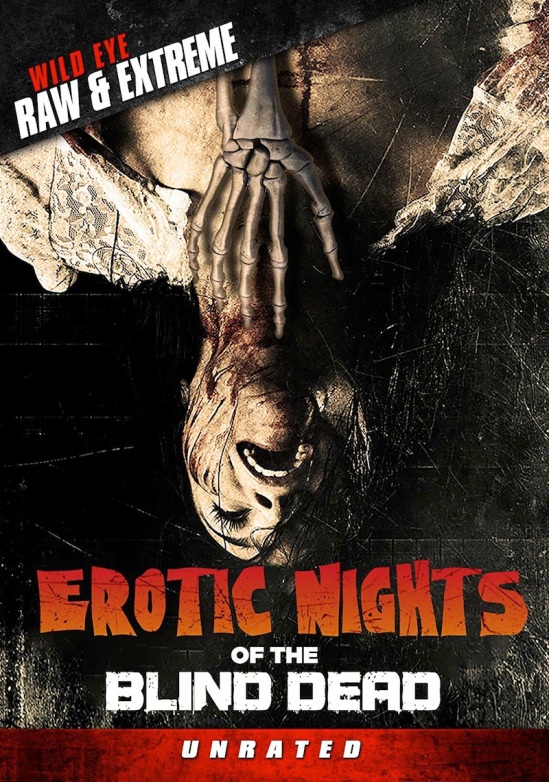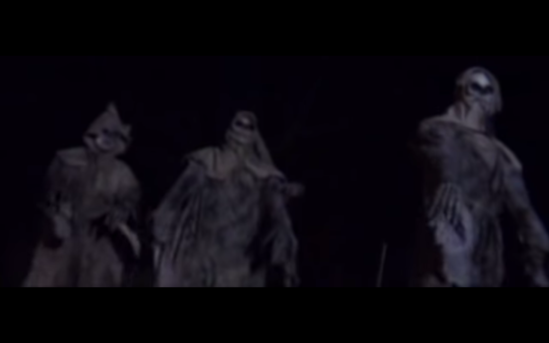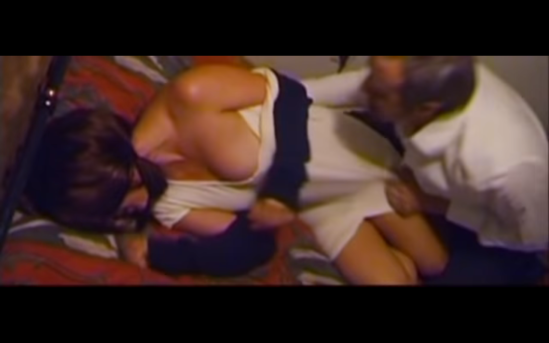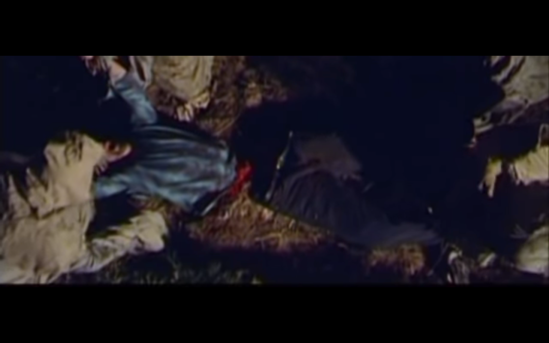
“Fisted!” is Guaranteed At Least One Laugh! Now on DVD!
Camp Counselor El Mo runs a camp of merciless sexual abuse and is driving his plaything campers to one their what’s sure to be an exploitational hike through nature but when the van suddenly explodes from underneath and a tire rod penetrates El Mo through the rectum and kills him, the seemingly resigned El Mo campers find their long-awaited plan for revenge has been circumstantially and unfortunately thwarted by chance. Determined not to be deterred for vengeance, the campers hike El Mo’s corpse to an isolated clearing where they will cook, eat, and excrete his remains but before they can do so, in the woods is the once urban legend turned real-life serial killer wearing a human flesh-masked, named The Jerklin’ Boy. With an angry fist that can explode someone in a single punch and a knack for ripping off their scrotum and attaching them to his mask, The Jerklin’ Boy is an unstoppable demonic evil force hellbent on destroying all in his path. There are even giant flesh-eating ants running rampant. With nowhere to turn, the campers are at the expertise mercy of a demon hunter disguised as a camper amongst them who was once tracking El Mo and has now changed course for The Jerklin’ Boy.

If a fan of Tom Martino’s outrageous and politically incorrect, 2012 science-fictional horror-comedy schlocker, “Race Wars: The Remake,” you might also want to check out another Martino indie feature filmed around the same time, a pseudo-SOV release that’s a horror-comedy with a punch! “Fisted!” is the Martino written-and-directed independent production produced shortly after “Race Wars: The Remake: and just like “Race Wars: The Remake,” it aimed to offend all without an apologetic backpaddling for its lack of decorum. Flagrant homosexuality stereotypes, raunchy cock-and-ball grotesqueness, off-color race tropes and gags, and much, much more lineup scene-after-scene in Martin’s indelicate and indecent return to the indie market. Once again, Martino produces his own film, as I’m sure no other company wants to touch it with a 100-foot pole, under his horror bust and mask-making company DWN Productions, which he shamelessly plugs in the middle of the story for good comedic measure.

Pulling form his pool of acting talent and making their returning are the Martino entourage actors Jamelle Kent and Howard Calvert. The “Race Wars: The Remake” lead actors find themselves out from the alien fast food and zombie-inducing drug trade business and into being assaulted and hurt campers DL and Dick looking to eat-revenge their abusive counselor. Joining them and also trading in his “Race Wars: The Remake” supporting character badge for a principal character badge is Kerryn Ledet as Schindler, the mastermind behind the rape-revenge plan. Ledet does the job but doesn’t hold a candle to Kent and Calvert’s dynamic duo in “Race Wars” with their a little extra something expressions compared to Kerryn’s over-the-top and crooked eyelevel facial stances. Joe Garcia plays a seriously unsettling and verbally aggressive molester in El Mo with other campers alongside Calvert, Kent, and Ledet in comedian Joking Jolly Rogers as the stachy Tiny, Liz McCarty as the lesbian Butch, Sam Rivas as the wheelchair bound Kurt, and Martino as sleepy Charlie. Martino doesn’t sleep the entire picture as he takes on the main antagonist role of The Jerklin’ Boy, who supposedly has dynamite running through his veins and gives him a punch that can knock your socks off and more! Danny McCarty, husband to Liz McCarty, is not only the co-editor of the film but dons the emo-gothic sheath of The Lords Palm Slayer, a demon hunter on an on-going fight to destroy evil. The Black Kreecha, aka Kreech Kreecha, makes his ode to the “Creature from the Black Lagoon” return from “Race Wars” to “Fisted!” with the simply named Steve, (voiced by Tynell Addison) as the beer drinking, slightly incestuous big brother to Kerryn’s Schindler. “Fisted!” rounds out with a few other colorful characters with Flamey the Bear (Tynell Addison), the pussywillow scientist (Joe Grisaffi), the drug-addicted blood pisser (Kevin Choate), the Groucho Marx bench perv Rodrigo Pena, and a profanity-loaded prologue and epilogue by legendary Clarence Reid in his iconic rapper identity Blowfly.

“Fisted!” is pansexually raunchy at its core and tapes into the same genre fan-living practical effects vein to the likes of Jeff Bookwalter’s “The Dead Next Door” minus the cut-and-paste visual effects that make Martino’s film all the more special in the eyes of the eccentric and underground indie film-loving beholder. Off the wall and off-color, “Fisted” doesn’t hold back the unglorified gags and is not trying to win any morality and ethical awards or honors anytime soon. The narrative is also divergent of any conventional narrative by be-bopping between the rape-revenge of the creepy molester El Mo, the scrotum snatching and wearing serial killer Jerklin’ Boy with an inexplicable powerful fist, the unexplained origin of large flesh-eating ants, and a demon hunting sect crusader who strays off the path of good. There’s a lot going on and a lot of vulgarity and a lot of fun happening here under the umbrella of ultra-low budget, underground cinema. “Fisted!” will not win the majority over and its niche comedy and contribution to science fiction horror doesn’t distill new and improved results into the genre but if you can relax from the high-strung conservative values and be open to a shoddy veneer and house made special effects ran through a VHS filter, “Fisted!” is a psychotic ass-punch of ridiculous fun with absurd practical and visual effects.

Coming in as the 92nd title for Wild Eye Releasing Raw & Extreme label, “Fisted!” is one insane grotesque death after another and this death punch of a film lands onto a new DVD with a MPEG2 compression encoding and an upscaled 720p albeit you wouldn’t be able to tell since there’s a heavy VHS filter that creates the impression of interlacing lines, tracking lines, and macroblocking as if watching a low rung SOV. The single layer DVD5 has a negligible effect since, again, the VHS filter puts the picture quality through the wringer but that’s Maritno’s intended veneer at a 90’s inspired grindhouse picture with the hot new tech of the era. My only complaint is the censored tracking lines overtop the plot critical moment where the lesbian action is not definitely simulated! A riveting scene that certainly made my brow sweat, profusely. The English language Stereo 2.0 suffers significant from poorly placed equipment and user error that often fights the natural elements, aka wind, and can also sound a bit boxy. With the gusts on the creek of an alligator-infested Missouri shore, ambience noise drowns out select dialogue scenes of exposition and performative utterances. There’s not much in the way of a memorable or killer soundtrack but the sound design to match the every aspect of the special effects lands with comedic flair, when there is actually audio synched with the action as occasionally it’s missed due to the 5-year post production change of hands. Bonus features include a Wild Eye produced commentary featuring director Tom Martino and actor Joe Garcia and the feature trailer plus other Wild Eye Releasing films. The DVD comes in a clear Amaray with uncredited, illustrative cover artwork of all its psychotronic insanity. The reverse side depicts a blown-up image of an outrageous death moment. The region free Wild Eye Releasing has a perfectly paced runtime of 71-minutes and is, of course, unrated.
Last Rites: Wild Eye Releasing continues to live up to their moniker with another wild, uncouth, and not rated story that barely has any narrative flesh hanging from the bone. “Fisted!” truly fights the conventional cinema power and doesn’t pretend to pull any punches as it takes on race, sexuality, and perversion without shame or any moral high ground.


















